The book in question is Unlimited Memory by Kevin Horsley. Rather than simply read the book, I wanted to turn this into an experiment. So I took a series of memory tests and repeated them having read the book. The results were pretty impressive!
Memory Tests
The website I used for the memory tests was Quantified Mind (now defunct) and the specific test series was called Basic Memory. I repeated the testing protocol fifteen times to narrow down the confidence interval for my scores. The scoring system is on an absolute level, based on results from all users, where higher is better. The exact battery of tests varied each time, but several were constant, leaving me with 15 sets of scores to collate.
Design Recognition
This involved being shown a 16 x 16 grid with a number of squares shaded black. After 3 seconds the grid disappears, and you’re asked to select the matching grid from a choice of four. If you are successful, the next pattern shown will be completely different, but will have one more black square than the previous grid. If you are incorrect, the number of black squares reduced by one (i.e. it becomes easier). The example below is with a total of 39 black squares. This test is around 4 minutes long.
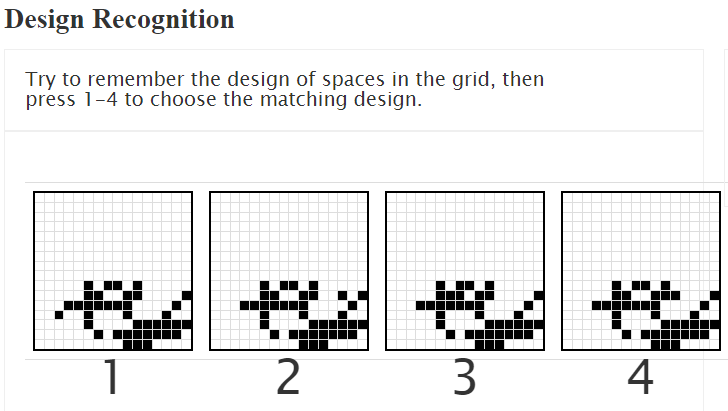
Design Copy
This test uses a smaller 8 x 8 grid, again with a series of black squares. This time you are shown it for five seconds, before you’re presented with a blank 8 x 8 grid and asked to recreate the pattern. As above, a successful answer means the following grid contains one extra black square, while a failure results in one less. This test is around 3 minutes long.
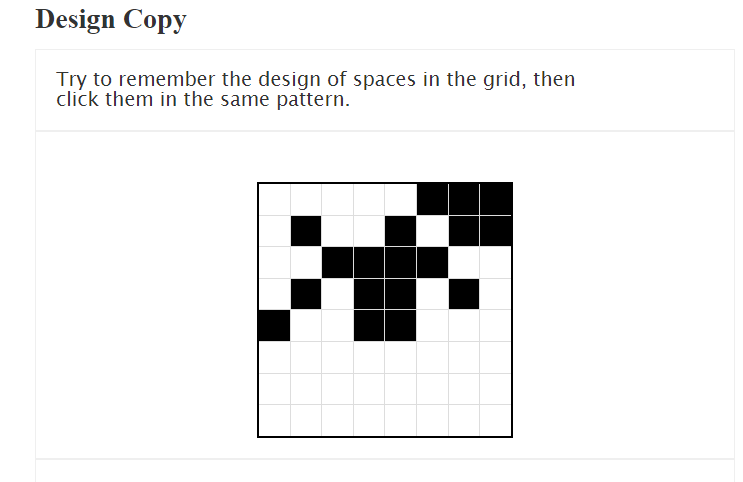
Self-Paced 3-Back
This is my personal favourite because it requires so much concentration to execute well. You are shown an initial selection of three random creatures – either a dinosaur, jellyfish, narwhal or snail. You then indicate with the keypad whether the next creature shown (the 4th image in the sequence) is the same or different to the one shown 3 images ago (the 1st image).
It’s easier to illustrate this with letters to denote the image order: After being shown A, B and C, you are then shown D, which you indicate is either the same or different to image A. That cycle continues, and you must compare image E with B, F with C, G with D and so on. This is repeated 120 times, so it also taxes your ability to intensely focus for extended periods.
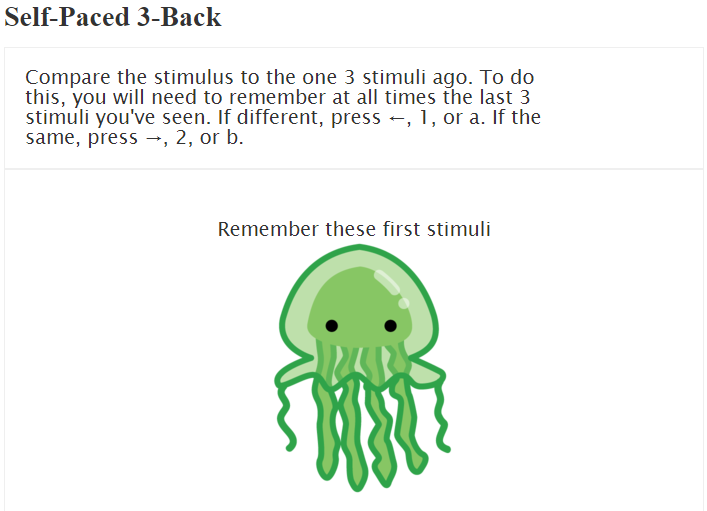
Beyond these three core tests were some others, from which I chose to record my scores of three others.
Visual Forward Digit Span
Here you are shown a sequence of numbers, one at a time, then asked to type them in order. If you are successful, the next sequence contains one more number, and if you are incorrect, it is one fewer. This is a longer test and lasts approximately 8 minutes.
Forward / Backward Spatial Span
These are two versions of the same memory test. Starting with a blank 5 x 5 grid, a sequence of squares will be highlighted one at a time for a period of 1 second. You are then either asked to click the same pattern (Forward) or click the pattern in reverse (Backward). As with other tests the sequence extends by one for a success and reduces by one for a failure. Your score is then determined by the average length of sequence you successfully memorised. Each of these tests lasts 3-4 minutes and a single battery of tests will only contain one version.
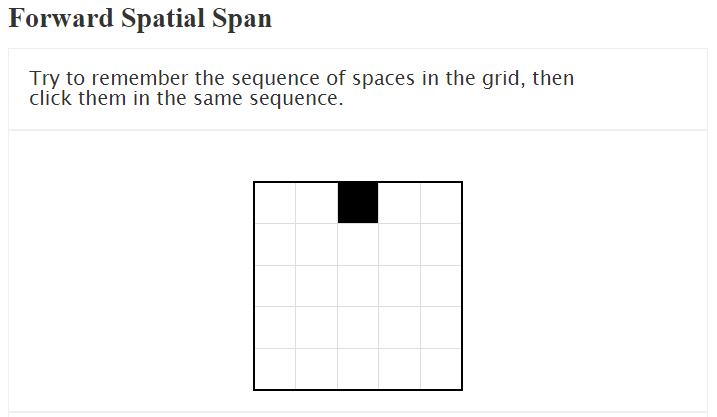
Memory Test Scores
My impression from the scoring system is that it is out of roughly 1000. That makes it possible to loosely compare scores across different tests to see where my strengths lie compared to the general population. For the three variable tests, my scores were as follows:
- Visual Forward Digit Span: Mean Score 674.4, Confidence Interval +/- 54.6
- Forward Spatial Span: Mean Score 559.1, Confidence Interval +/- 29.9
- Backward Spatial Span: Mean Score 586.6, Confidence Interval +/- 45.0
Design Recognition
Mean Score: 634.4
Confidence Interval: +/- 33.2
Looking at the sequence of individual scores, there was a steady improvement at the beginning. My first six tests were all below 600, and my final 9 tests were all above 625. The mean of my final 9 tests is 676 +/- 25. This was mainly due to the initial difficulty being based on the end of the previous test, and so it wasn’t as challenging for the first few.
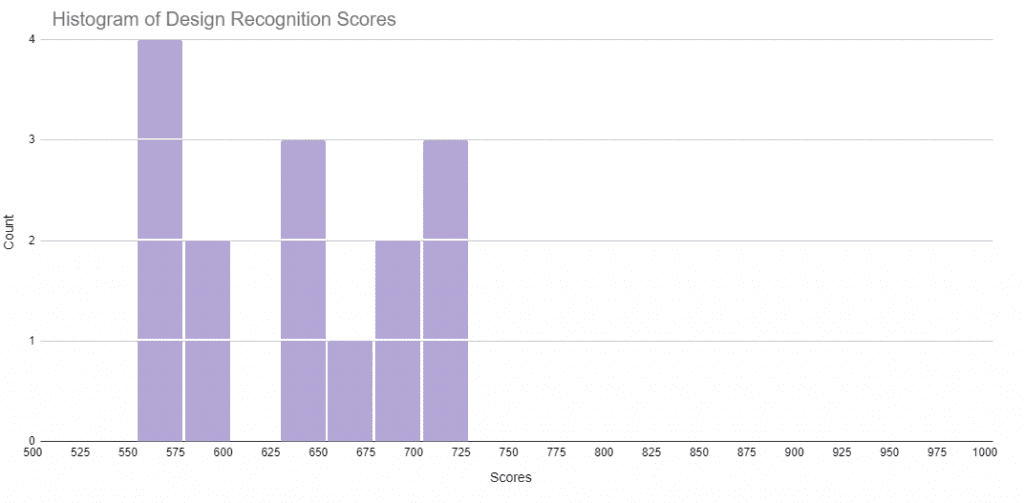
Design Copy
Mean Score: 734.3
Confidence Interval: +/- 29.0
This test was quite consistent, I would generally hover around 750 but the distribution of squares sometimes worked in my favour. There were cases where I’d have to remember the position of 13 black squares but 12 of them were in a 4 x 3 rectangle. Overall it felt like I’d established an accurate mean with a narrow confidence interval.
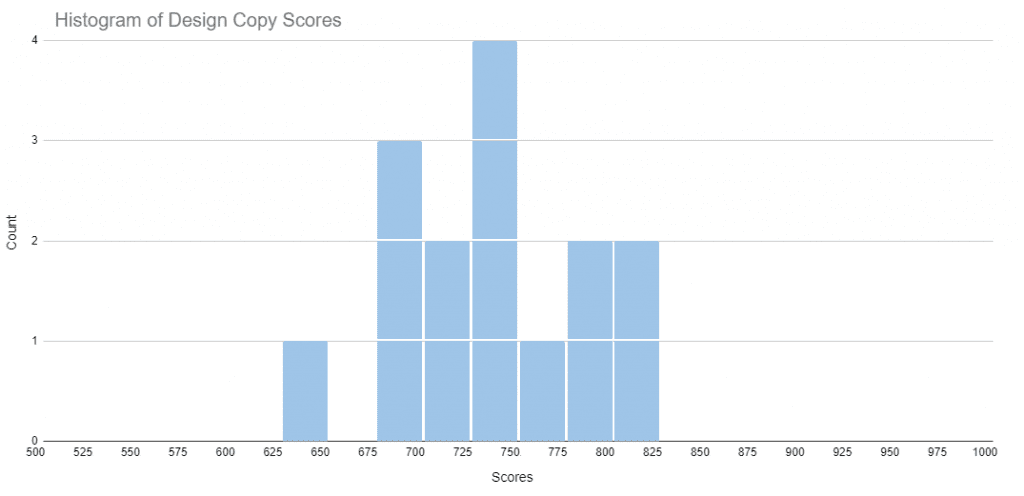
Self-Paced 3-Back
Mean Score: 570.3
Confidence Interval: +/- 22.3
This chart actually hides a data point, my first score of 486, but by the third trial I had found a method that worked for me and had very little variation in results. My final 10 results were all between 564 and 598, with a mean of 585 +/- 7.
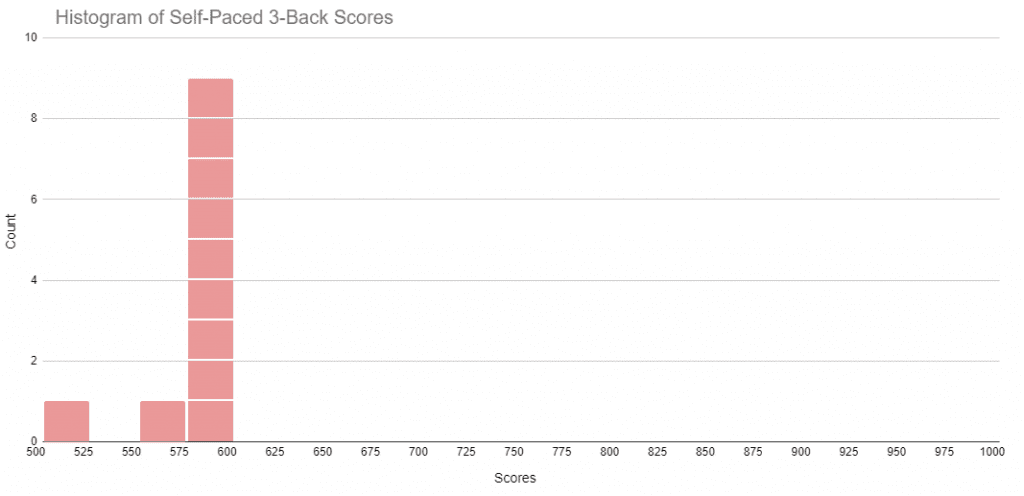
Applying the Methods in the Book
I had no idea what I was going to learn from the book when I took these initial tests. It became apparent that the methods are easier to apply to some tasks than others. I’ll present the retest results from least to most impressive.
Forward Spatial Span
Initial Score: 559 +/- 30
New Score: 571 +/- 43
This was the test where I had to repeat a sequence of black squares in the same order as I saw it. I tried to mentally “animate” the grid somehow, imagining someone jumping from square to square, but it made very little difference.
Design Recognition
Initial Score: 634 +/- 33
New Score: 651 +/- 28
As I mentioned earlier, there was a slow start to this one and by the 7th trial I didn’t dip below 625, averaging 676 +/- 25. The methods in the book are excellent for committing things to medium term memory and I found it hard to implement anything for this specific test.
Self-Paced 3-Back
Initial Score: 570 +/- 35
New Score: 612 +/- 15
Again, this is one where the first few trials dragged down my average, which would otherwise have been 585 +/- 7. I would attribute my improvement to being a little faster to react at the expense of some accuracy. There are 120 trials and I was often getting 119 or 120, but I found that going slightly faster and perhaps finishing on 117/120 gave slightly better scores.
Design Copy
Initial Score: 734 +/- 29
New Score: 849 +/- 31
I only made a small tweak to the way I approached this challenge but it made a significant difference to my scores. The change I made was to identify known Tetris shapes within the pattern, and use them as a reference point for the other shapes. Here’s the earlier example, then how I would break it down in my head.
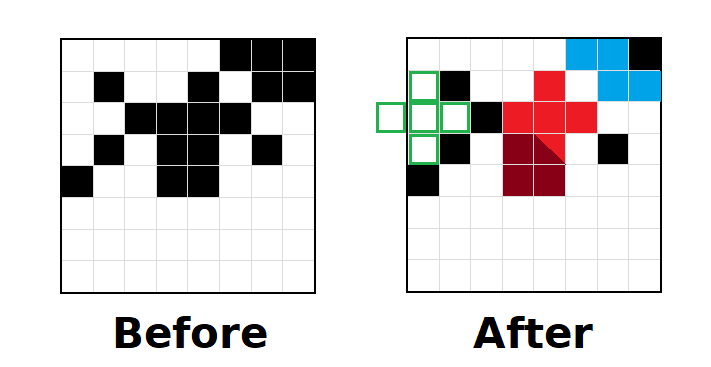
The central plus sign catches my eye first, soon followed by the blue shape in the top right. I can then picture a 2 x 2 square emerging from the base of the plus. Finally the white squares on the left can fit another plus, with a one square gap to the original red plus sign. All of this has to happen in five seconds and some patterns lend themselves to this method more than others.
Overall this approach boosted my average score by 115.
Backward Spatial Span
Initial Score: 587 +/- 45
New Score: 815 +/- 59
While the forward spatial span had no improvement, I found a method that helped in the reverse. When the 5 x 5 grid started lighting up with single black squares, I translated the first three elements into numbers. I would then memorise the remaining sequence as normal. I would then enter the sequence backwards, recall the three numbers, and enter those in reverse to complete the sequence. Here’s how it looks visually.
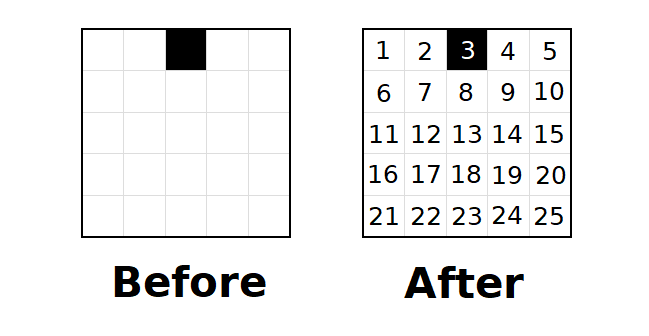
So here the first square is the top row, third across. Using my number grid, this represents “3”. I would do this for the first three black squares, for example, 3 – 14 – 20. After that I’d use my visual memory on the remainder of the sequence. It then asks you to repeat the pattern in reverse, so once I’d entered the sequence stored in my visual memory, I’d recall 3 – 14 – 20, reverse it, 20 – 14 -3, and find the corresponding squares. In effect this extended the length of sequence I could memorise by three squares.
Overall this approach boosted my average score by 225.
Visual Forward Digit Span
Initial Score: 674 +/- 55
New Score: 918 +/- 91
In the final test you see a sequence of single digits and have to type them out in order. Here I employed a number to letter conversion taught in the book, which is as follows:
- Numbers represent a choice of consonants or sounds, so a 3 is M (because “M” looks like a 3 on its side). Other examples are 2 = N, 4 = R, 5 = L and 8 = F or V.
- Convert a number sequence into letters, then use vowels as free characters to create a word.
- Use the other methods in the book to remember the words
The way I approached it was to take the first three pairs of numbers and convert them to words on the fly, quickly creating a story around it. My scores improved with practice as I increased the speed at which I could mentally recall the corresponding letters for each number. A (contrived) worked example would be 335143459082450.
- 33 = MM, which I would quickly convert to the word “mum”. I bring up a mental image of a mum and prepare to create an action involving the next numbers.
- 51 is LT or LD, I select LT and decide that the mum has “lit” something on fire. The object will be the final pair.
- 43 is RM. So the mum has lit some “rum” on fire. I picture the mum at a bar with a shot glass of rum, lighting it on fire.
- The next numbers I remember as three digit sequences, similar to how people recall phone numbers. I don’t need to actively think about the mum lighting rum, so I can focus on remember 459 082.
- For the remainder of the sequence I just hope that my visual memory can capture it, and when presented with the text box I will quickly enter the visually stored part of the sequence first while it’s still fresh, all while repeating 459 082 in my head.
- After entering 450, I move the cursor to the start of the sequence and type in 459082.
- The final step is to translate mum back to 33, lit back to 51 and rum back to 43.
With this method I was able to memorise around 17 digits in a row, raising my average score by 244.
Conclusions
In hindsight, the memory tests I chose were very ill-suited to the methods I learned in the book.
- The methods are best suited to creating medium term memories, information you want to remember for months not days.
- However, their application also takes time. It took me an hour to construct a story involving all 46 of the US presidents, but once it was done I could recall it with ease.
- The Quantified Mind tests are time restricted, allowing a maximum of five seconds for any single piece of information.
- Since each test involves repeated trials, it actually hinders you to remember something that relates to the previous trial. If I remember the three digit sequence 3-14-20, I want to recall it a minute later but then immediately forget it in place of the next sequence.
With all that being said, the places I did apply it hopefully proved how valuable these tools can be. I would be comfortable saying that given several hours I could memorise a sequence of 100 digits. I would do this by converting to letters, then words, and building a story.
If you’re still not convinced, please check out my review of Unlimited Memory by Kevin Horsley.

